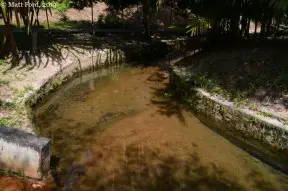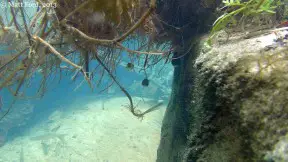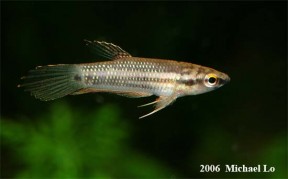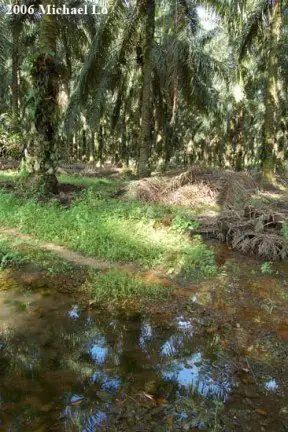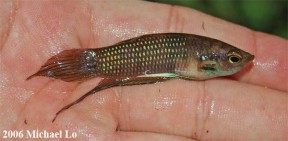Betta pugnax
SynonymsTop ↑
Macropodus pugnax Cantor, 1849; Betta bleekeri Regan, 1910; Betta macrophthalma Regan, 1910; Betta brederi Myers, 1935
Etymology
Betta: from ikan betah, the vernacular Malay for species of this genus.
pugnax: from the Latin pugnax, meaning ‘combative’.
Classification
Order: Perciformes Family: Osphronemidae
Distribution
Distributed throughout much of Peninsular Malaysia with records from the states of Kedah, Terengganu, Pahang, Penang, Perak, Selangor and Johor. It is also known from Singapore.
Type locality is ‘Penang, Malaysia’.
Habitat
In Penang it has been collected from shallow (10 – 80cm deep), flowing parts of clear water hill streams and foothills. The substrate is most often sandy with little to no aquatic vegetation and the fish can be found among submerged leaf litter or sheltering under overhanging marginal vegetation and tree roots. In Johor the species is also know to inhabit flowing streams, some of which contain large quantities of submerged vegetation.
Other populations inhabit stiller forest swamps and associated streams. These environments are usually shaded from the sun, the dense canopy of branches above meaning very little light penetrates the water surface. Marginal vegetation also tends to grow thickly. The water itself is typically stained with humic acids and other chemicals released by decaying organic material and is usually acidic with negligible hardness.
Much of its natural range has been heavily-modified, with conversion of the original forest to oil palm plantations particularly common, and it can be found in ditches and channels within these cultivated areas.
Maximum Standard Length
60 – 70 mm.
Aquarium SizeTop ↑
An aquarium with base measurements of 80 ∗ 30 cm or equivalent is large enough for a pair or small group.
Maintenance
Can be maintained in a fully-decorated aquarium although many breeders prefer not to use a substrate for ease of maintenance. Driftwood roots and branches can be used and placed such a way that a few shady spots are formed, while clay plant pots or lengths of piping can also be included to provide further shelter.
The addition of dried leaf litter offers additional cover and brings with it the growth of microbe colonies as decomposition occurs. These can provide a valuable secondary food source for fry, while tannins and other chemicals released by the decaying leaves are considered beneficial for fishes from blackwater environments. There is no need to use natural peat, however, the collection of which is both unsustainable and environmentally-destructive.
Like others in the genus this species seems to do best under fairly dim lighting. Aquatic plant species that can survive under such conditions include Microsorum, Taxiphyllum or Cryptocoryne spp., while floating vegetation is also appreciated by the fish.
This species requires acidic conditions with negligible carbonate hardness and very low general hardness, meaning a reverse osmosis unit or other method of obtaining soft water may need to be employed. This can be further acidified using phosphoric acid or similar if necessary.
As it naturally inhabits sluggish waters filtration should not be too strong, with an air-powered sponge filter set to turn over gently adequate. Keep the tank well-covered and do not fill it to the top as like all Betta spp. it requires occasional access to the layer of humid air that will form above the water surface, and is an excellent jumper.
Water Conditions
Temperature: 22 – 28 °C
pH: 4.0 – 7.5
Hardness: 18 – 179 ppm
Diet
Likely to prey on aquatic and terrestrial invertebrates in nature.
Captive fish will normally accept dried products once they are recognised as edible, but should be offered plenty of small live or frozen foods such as Daphnia, Artemia or chironomid larvae (bloodworm) regularly to ensure development of optimal colour and condition.
Take care not to overfeed as Betta spp. seem particularly prone to obesity.
Behaviour and CompatibilityTop ↑
Not recommended for the standard community aquarium. Its care requirements and disposition mean it is best kept alone or with very peaceful species. Some small cyprinids and loaches that inhabit similar environments in nature are suitable, but proper research prior to purchase is essential and in most cases it is best maintained alone.
It is not among the more aggressive members of the genus and can be maintained in a pair or group.
Sexual Dimorphism
Males grow larger, possess a greater amount of iridescent scaling on the head, a broader head shape, and more extended fins than females.
Reproduction
Paternal mouthbrooder. Ideally organise a separate aquarium for breeding purposes, unless the fish are already being maintained alone.
The aquarium should have the tightest-fitting cover possible (some breeders use clingfilm/plastic wrap) because the fry need access to a layer of warm, humid air without which development of the labyrinth organ can be impaired.
Following a protracted courtship, eggs and milt are released during an ’embrace’ typical of osphronemids, with the male wrapped around the female. Several ‘dummy’ embraces may be required before spawning commences.
Fertilised eggs are caught on the anal fin of the male then picked up in the mouth of the female before being spat out into the water for the male to catch. Once the male has all the eggs in his mouth the process is repeated until the female is spent of eggs, a process which can take some time.
A brooding male may swallow or release the eggs prematurely if stressed or inexperienced, so it is preferable to leave the female and any other fishes in situ. The incubation period is 9-16 days, after which the male will begin to release free-swimming fry. At this point they can be removed or left to grow alongside the parents, though some may be lost to predation under the latter circumstances.
The fry are large enough to accept motile foods such as microworm and Artemia nauplii immediately, though it should be noted that there exist reports of young Betta developing health issues if fed excessive amounts of the latter. Water changes should be small and regular rather than large and intermittent.
NotesTop ↑
This species lends its name to the B. pugnax complex of closely-related species within the genus, an assemblage within which members share the following combination of characters: relatively large head measuring 28-40% SL; live colouration usually brown with green or blue iridescent spots; male with similarly-coloured scales on opercle, sometimes extending to abdomen; juveniles and females usually brown with two central body stripes and a dark marking on the caudal peduncle; anal-fin in mature specimens pointed and often elongated; caudal-fin lanceolate.
It can be told apart from other members of the B. pugnax group by the following characters: chin bar present; no complete second postorbital stripe on opercle; presence of transverse bars in caudal-fin of males; caudal-fin in males broadly lanceolate; opercle scales iridescent blue; anal-fin with reddish subdistal band and black margin; caudal-fin without dark margin; 25-28 anal-fin rays; 28-31 lateral scales; 11-12 postdorsal scales; length of pelvic fins 26.6-43.8 % SL; length of head 27.5-35.2 % SL; inter-orbital width 32.4-53.0 % HL.
The genus Betta is the most speciose within the family Osphronemidae. Members have successfully adapted to inhabit a variety of ecological niches from stagnant ditches to flowing hill streams including some extreme environments such as highly acidic peat swamp forests.
The referral of members to a number of groups containing closely-related species is largely based on morphological and behavioural characters. A full list of the species groups as currently recognised can be found here.
Like others in the suborder Anabantoidei this species possesses an accessory breathing organ known as the labyrinth, which permits the fish to breathe atmospheric air to a certain extent. Comprising paired suprabranchial organs formed via expansion of the epibranchial (upper) section of the first gill arch and housed in a chamber above the gills, it contains many highly-vascularised, folded flaps of skin which function as a large respiratory surface. Its structure varies in complexity between species, tending to be more developed in those inhabiting harsher environments.
References
- Cantor, T. E., 1849 - Journal of the Asiatic Society of Bengal 18(2): i-xii + 983-1443
Catalogue of Malayan fishes. - Kottelat, M., 2013 - Raffles Bulletin of Zoology Supplement 27: 1-663
The fishes of the inland waters of southeast Asia: a catalogue and core bibiography of the fishes known to occur in freshwaters, mangroves and estuaries. - Tan, H. H. and P. K. L. Ng, 2005 - Raffles Bulletin of Zoology Supplement 13: 43-99
The fighting fishes (Teleostei: Osphronemidae: Genus Betta) of Singapore, Malaysia and Brunei. - Tan, H. H. and P. K. L. Ng, 2005 - Raffles Bulletin of Zoology Supplement 13: 115-138
The labyrinth fishes (Teleostei: Anabantoidei, Channoidei) of Sumatra, Indonesia. - Tan, H. H. and S. H. Tan, 1996 - Raffles Bulletin of Zoology 44(2): 419-434
Redescription of the Malaysian fighting fish Betta pugnax (Teleostei: Belontiidae), and description of Betta pulchra, new species from Peninsular Malaysia.

